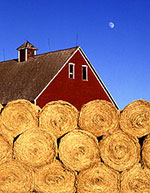The Aug. 16 issue of Science magazine features an ominous headline: “Dead Zone Grows.” To the right of the headline is a map of the Gulf of Mexico with an irregular green stripe hugging the shoreline. This is the Dead Zone, an area of the gulf where oxygen levels are so low that most marine organisms — including crab and shrimp — cannot survive. A primary cause of the problem is fertilizer runoff from farms in the Mississippi River watershed. The runoff stimulates algae blooms. When the algae die, they sink to the bottom and decompose, using up oxygen in the process. This year, the Dead Zone is bigger than ever before — nearly 8,500 square miles, an area larger than New Jersey.

Map: U.S. EPA.
The Dead Zone may be the headline grabber, but it is only one of many impacts of our contemporary agriculture system. Irrigation leads to aquifer depletion, herbicides accumulate in groundwater, manure from hog farms pollutes rivers, and the full impacts of genetically modified crops on ecosystems are not yet known. Put it all together and you might be tempted to point your finger at farmers. After all, they are the ones out there applying the chemicals and planting the genetically modified seeds. But after spending four years working on a project to understand the root causes of issues like these in corn production, I can tell you that the problem doesn’t lie with farmer greed or indifference; it lies with economics.
Farmers — like all entrepreneurs in free-market systems — compete to stay in business. The terms of that competition are clearly defined. Who can produce the most grain for the least cost of labor, land, machinery, and inputs (such as seed and fertilizer)? The farmers who are the best at maximizing this equation — the most “efficient” farmers — are the most likely to stay in business. As the “least efficient” farmers and farming practices disappear, farming as a whole becomes more and more efficient. This has brought enormous innovation and gains in productivity. Yields of corn, for example, have risen from about 30 bushels per acre in 1940 to around 120 bushels per acre today.

Land o’plenty of problems.
Photo: USDA.
Achieving that kind of efficiency is the promise of our market-based system, and in many ways, it’s a good thing; theoretically, at least, more people could be fed with less land. But what about the Dead Zone, the herbicides in groundwater, the manure in streams? Wouldn’t a really efficient solution to human needs include a healthy fishery downstream of our farms, and plenty of pure water beneath them? Why hasn’t the free-market system — our most vaunted tool for solving humanity’s problems — delivered these goods as well?
After interviewing farmers, farm advocates, environmentalists, and policy makers, my colleagues and I have concluded that part of the answer lies in our society’s definition of efficiency. The kind of efficiency that determines whether a farmer earns a profit and manages to hold on to his land is a very particular efficiency. It is the efficiency of producing just one thing — a single crop — with the frugal use of a few other things — labor, land, equipment, and so forth. There is nothing in this equation about maintaining the health of the Gulf of Mexico. That is why the Gulf of Mexico has a Dead Zone and why that Dead Zone is growing.
It doesn’t have to be this way. There is nothing in our current definition of efficiency that is a natural law. We could reorient our thinking to expand what we reward. We could begin to think of clean water and healthy soil the way we think of wheat and barley — as products of farming. Many European countries have done just that; they hold farmers responsible for water purification and biodiversity as well as crops, and offer payments for these kinds of productivity.

Misting the point: spraying with diswashing detergent and cooking oil.
Photo: USDA.
In addition to expanding what outcomes we reward, we could expand the list of things we want our farmers to be frugal with. There is a clear economic incentive to be frugal with labor and capital; why not also with soil, water, and community quality of life? Getting our markets to work for us requires figuring out how to reward the careful use of these resources.
It’s not that we lack the policy instruments. Economists already have a toolbox full of suggestions, from stewardship payments to pollution taxes, to encourage ecologically friendly agricultural practices. But we won’t make use of these tools until we stop expecting that competition on a narrow definition of efficiency can somehow deliver broader goals. That is like a university selecting its first-year class based only on SAT scores and then expecting the students to excel at football and chamber music.
These are not things to be left up to chance. If you want football and music — or healthy water and thriving ecosystems — these goals must shape the criteria that determine who is successful enough to participate in your system. Just as the university’s admissions criteria must give some credit to musical or athletic skill, we need to use tools such as taxes and payment incentives to make sure that the most profitable farmers are the ones whose farms produce healthy food, healthy water, healthy topsoil, and healthy habitat. When our policy is informed by such an expanded definition of efficiency, oxygen levels will rise once more in the gulf, and the headlines will proclaim, “The Dead Zone Is Shrinking.”

